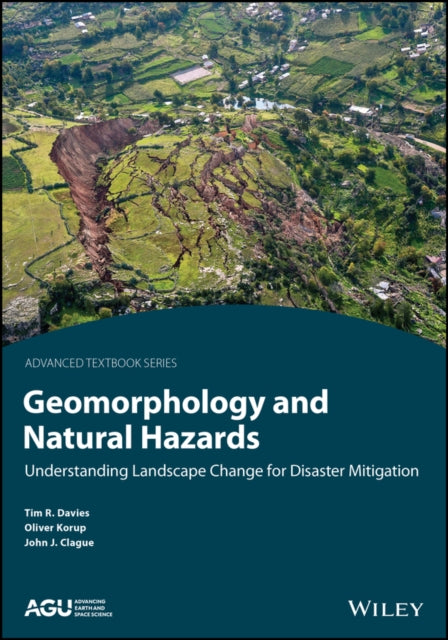Timothy R. H. Davies,Mauri McSaveney,Oliver Korup
Geomorphology and Natural Hazards: Understanding Landscape Change for Disaster Mitigation
Geomorphology and Natural Hazards: Understanding Landscape Change for Disaster Mitigation
YOU SAVE £4.62
- Condition: Brand new
- UK Delivery times: Usually arrives within 2 - 3 working days
- UK Shipping: Fee starts at £2.39. Subject to product weight & dimension
Bulk ordering. Want 15 or more copies? Get a personalised quote and bigger discounts. Learn more about bulk orders.
Couldn't load pickup availability
- More about Geomorphology and Natural Hazards: Understanding Landscape Change for Disaster Mitigation
Natural disasters are intense events that can cause catastrophic landscape change. Geomorphology and Natural Hazards: Understanding Landscape Change for Disaster Mitigation is a textbook that explores the natural hazards resulting from landscape change and how an Earth science perspective can inform hazard mitigation and disaster impact reduction.
\n Format: Paperback / softback
\n Length: 576 pages
\n Publication date: 22 April 2021
\n Publisher: John Wiley and Sons Ltd
\n
Natural disasters are infrequent yet severe occurrences that cause significant disruptions to the Earth's surface. These events, including earthquakes, volcanic eruptions, droughts, and storms, have the potential to induce catastrophic transformations in the landscape through processes such as erosion, transportation, and deposition of diverse materials. Geomorphology, the study of landforms and their processes, plays a crucial role in understanding the dynamics and consequences of natural hazards.
Geomorphology and Natural Hazards: Understanding Landscape Change for Disaster Mitigation is a comprehensive graduate-level textbook that delves into the natural hazards resulting from landscape change and demonstrates how an Earth science perspective can inform hazard mitigation and disaster impact reduction. The book offers valuable insights into various aspects of hazards, risks, and disasters.
Volume highlights include:
Definitions of Hazards, Risks, and Disasters: This section provides a comprehensive overview of the terms used to describe natural hazards, their characteristics, and the potential impacts they can have on the Earth's surface.
Impact of Different Natural Hazards on Earth Surface Processes: The book explores the diverse ways in which different natural hazards exert their influence on Earth's surface processes, including erosion, sedimentation, landslides, and subsidence. It highlights the geomorphologic mechanisms that contribute to the formation and evolution of hazardous landscapes.
Geomorphologic Insights for Hazard Assessment and Risk Mitigation: Geomorphology provides valuable insights into the processes that shape the landscape and the factors that contribute to the vulnerability of different areas. By understanding these insights, geomorphologists can develop models and tools for hazard assessment and risk mitigation, which are essential for effective disaster management.
Models for Predicting Natural Hazards: The book discusses the development and application of models that predict the occurrence and intensity of natural hazards. These models utilize various scientific principles, such as physics, meteorology, and geomorphology, to simulate the behavior of natural systems and provide estimates of potential impacts.
How Human Activities Have Altered Natural Hazards: The book explores the impact of human activities on natural hazards, including deforestation, urbanization, and climate change. It highlights the ways in which human actions have altered the natural environment, increasing the susceptibility to hazards and exacerbating their impacts.
Complementarity of Geomorphology and Engineering to Manage Threats: Geomorphology and engineering are closely intertwined in the management of natural hazards. The book emphasizes the complementarity of these two fields and discusses the ways in which they can be used together to develop effective strategies for hazard mitigation and disaster impact reduction.
In conclusion, Geomorphology and Natural Hazards: Understanding Landscape Change for Disaster Mitigation is a valuable resource for students, researchers, and practitioners interested in the study of natural hazards and their impact on the landscape. The book provides a comprehensive understanding of the processes that shape the Earth's surface and the factors that contribute to the vulnerability of different areas. By integrating an Earth science perspective into hazard mitigation and disaster impact reduction, the book offers valuable insights and strategies for building resilient and sustainable communities.
\n Weight: 1172g\n
Dimension: 179 x 254 x 32 (mm)\n
ISBN-13: 9781119990314\n \n
This item can be found in:
UK and International shipping information
UK and International shipping information
UK Delivery and returns information:
- Delivery within 2 - 3 days when ordering in the UK.
- Shipping fee for UK customers from £2.39. Fully tracked shipping service available.
- Returns policy: Return within 30 days of receipt for full refund.
International deliveries:
Shulph Ink now ships to Australia, Belgium, Canada, France, Germany, Ireland, Italy, India, Luxembourg Saudi Arabia, Singapore, Spain, Netherlands, New Zealand, United Arab Emirates, United States of America.
- Delivery times: within 5 - 10 days for international orders.
- Shipping fee: charges vary for overseas orders. Only tracked services are available for most international orders. Some countries have untracked shipping options.
- Customs charges: If ordering to addresses outside the United Kingdom, you may or may not incur additional customs and duties fees during local delivery.


